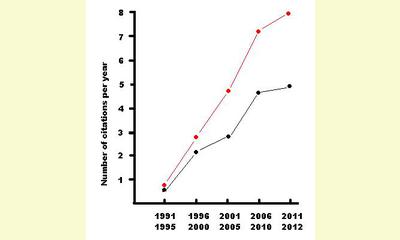|
|
The culture of peace concept is advancing
un article par David Adams
Several years ago I made a quantitative analysis
of the advance of the concept of human rights over
the years. The resulting graph is quite spectacular. For the
first few decades after 1948 when the Universal
Declaration of Human Rights was adopted, there was
scarcely any reference to human rights in the
academic literature. Then references started to
pick up in the 1990's and by the first decade of
this century there was over 10,000 references a
year. Probably the Nobel Prize to Amnesty
International in 1977 played a role in this
dramatic increase.

Number of citations per year of "culture of peace" in the academic literature: Sociological Abstracts in red; Science Citation Index in black
click on photo to enlarge
So recently I decided to do a similar analysis for
the concept of the culture of peace over the years
since it was supported by resolutions at UNESCO
and the United Nations beginning in 1992. Here is
the graph for academic references, using data from
the Social Science Citation Index (black) and
Sociological Abstracts (red). The former can only
be done for English, while the latter includes
data from Spanish, French and Portuguese as well
as English.
Although there is a clear advance shown on the
graph, the numbers are still tiny in comparision to
the figures for human rights which are 10,000 per
year.
It may be considered that academics are always
somewhat slow to pick up a new concept, and so I
have looked also at references to culture of peace
on an Internet search engine for news sources
(Google news). Here the numbers are more
impressive for today (February 14): 74 references
to "culture of peace", 54 references to "culture
de paix" or "culture de la paix" and 63 references
to "cultura da paz" (Portuguese).
But the big surprise, which is very good news, is
the number of references to the Spanish version
"cultura de paz." As of today there are 1,540
recent news articles listed in Google news with this
phrase!
Perhaps one should not be surprised since, on the
basis of the many articles from Latin America in
last month's CPNN bulletin, I wrote
in my monthly blog that Latin
America is the "leading edge" of the global
movement for a culture of peace.
|








|
DISCUSSION
Question(s) liée(s) à cet article:
How can we know if the culture of peace is advancing?,
* * * * *
Commentaire le plus récent:
One way we can NOT know if the culture of peace is advancing is from projects like the Global Peace Index which has recently been reviewed in CPNN.
The Global Peace Index measures the old dimensions of war and peace, not the new dimensions of culture or war / culture of peace. Peace, in the old paradigm was the period between wars when countries were preparing themselves for the next war. Culture of Peace, the new paradigm, is concerned with the deep roots of war, its cultural basis.
That can explain the paradox that it is the wealthy countries of the North that score highest on the index (Denmark, Austria, Switzerland and Finland), countries of Europe, which was involved in both the World Wars and which continue to profit from the unequal terms of trade between North and South which is enforced by the culture of war.
When I was at UNESCO, the African ambassadors had the following to say: "One should not look to the South for the causes of the culture of war; instead, pose three questions. From where do the weapons come? From where do the violent television programmes come? And where are the terms of trade decided that impoverish the people of the South which leads to violence? "

|
|









